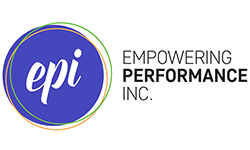Do Team Differences Spook You?
I have a pretty awesome team at EPI. Each of our team members brings something spectacular to the table, which has got me thinking about how that came about.
Consider your own team. Does everyone react the same way to a situation or a project? Is one person reserved, while another is outgoing? Does one appear passive and another assertive? Have you noticed that one person prefers the Big Picture but someone else likes digging into the nitty-gritty details? And can these teammates work together to produce great work?
Simply put, yes. It’s not only possible… it’s downright imperative! Having a variety of people and behavior types creates a strong and results-driven team.
Don’t be spooked by your team's differences… be in awe of the magic they can create together.
My team is made up of a dynamic group of women. While there are similarities among them, there are also many differences. And I like it that way. I built my team to be purposefully different because it ensures we produce great work that is a compilation of varying skills, thought processes, and ideas. One way we've determined the team’s variety of behaviors and how we can work together most effectively is through the Everything DiSC® assessment.
The DiSC Model of Behavior was developed by physiological psychologist William Marston and dates back to his 1928 book, Emotions of Normal People. Since then, alongside psychological studies and research, his theory has evolved into a modern tool used by many business leaders. DiSC is a personal development tool specifically designed for the workplace. It assesses and measures a person’s preferences and tendencies and aligns them with four major behavioral styles: Dominance, Influence, Conscientiousness, and Steadiness.
As a leader, you want all four DiSC styles represented on your team because each style has a unique set of strengths.
Whether those strengths include focusing on results, relationships, or details, the DiSC assessment is a way to learn about each style and how they work together. You can use DiSC to improve communication, people skills, emotional intelligence, and approach. Understanding DiSC can create something that seems almost… MAGIC.
No one DiSC style is better than another. In fact, everyone is a blend of all four styles. But each person tends to have a dominant behavioral style. The four different styles represented within the DiSC learning experience are:
Dominance: active and questioning
Those with a behavior pattern most influenced by the Dominance (D) element tend to solve new problems assertively and efficiently, take a direct approach to achieving results, and are motivated by competition, winning, and success. They are less likely to display sensitivity or show patience, but they value competency, action, challenges, and tangible results. If you know me, it probably comes as no surprise that my dominant style is "D."
Influence: active and accepting
Someone with an Influence (i) style values relationships and tends to shape their environment by influencing or persuading others. An "i" is often described as a "people person." These folks are optimistic, enthusiastic, and convincing. An Influence style is motivated by social recognition, group activities, and relationships. They're less likely to research all the facts and don't like being ignored. Moreover, they value coaching, seek friendships, and prioritize taking action. We have several "i" styles on our team, which is one reason we partner so well with our varied clients. My secondary style is "i" and it comes out most when I'm in one-on-one interactions.
Steadiness: thoughtful and accepting
Those with the Steadiness (S) behavior style focus on cooperating with others to carry out a specific task. They're often described as patient, calm, consistent, and deliberate. A Steadiness style is motivated by collaboration and opportunities to help others. They value stability and giving support; however, they tend to dislike change, promoting themselves, or confrontation. I love to promote EPI and talk up the good work my people do, so you can see I am no "S." But we do have a couple of "S" styles on our team and they are our rocks.
Conscientiousness: thoughtful and questioning
Those with a Conscientiousness (C) pattern tend to be private, logical, and analytical individuals. They prioritize maintaining stability, ensuring accuracy, and challenging assumptions. Often described as tactful, deliberate, and systematic, "C" styles may have trouble delegating tasks, making quick decisions, or compromising. But I'm the Big Picture person and I couldn't get along without our "Cs" to handle the details.
DiSC is an invaluable business asset that more and more companies are using to build improved teams. A 2014 global survey of HR professionals discovered 62% of respondents already use some form of personality and/or behavior assessment to vet potential hires, while 30% intend to use such assessments in the future.
How can DiSC help your organization?
You'll gain knowledge and feel more empowered because of it.
Team performance will improve and productivity will increase.
You and your teammates will communicate more effectively.
DiSC provides a new way to give and receive feedback.
Investing in your workforce with DiSC can drive greater results.
Empowering Performance, Inc. is an award winning, certified DiSC provider. We have helped thousands of professionals assess their behavioral styles and, in turn, understand more about themselves and their coworkers. In addition, as a team we routinely revisit our DiSC profiles and discuss our motivators and stressors so we can continue to learn about each other.
It might scare you to have people on your team who are different. But in order to grow, we must surround ourselves with people who aren’t like us… as spooky as that might be sometimes.
I believe the best leaders purposefully create a team that is greater than the sum of its individual contributors. Yes, it's based in science, but it sure seems like magic!
Everything DiSC® is a registered trademark of John Wiley & Sons, Inc.
Michelle Kelly, CEO (Chief Enjoyment Officer)


